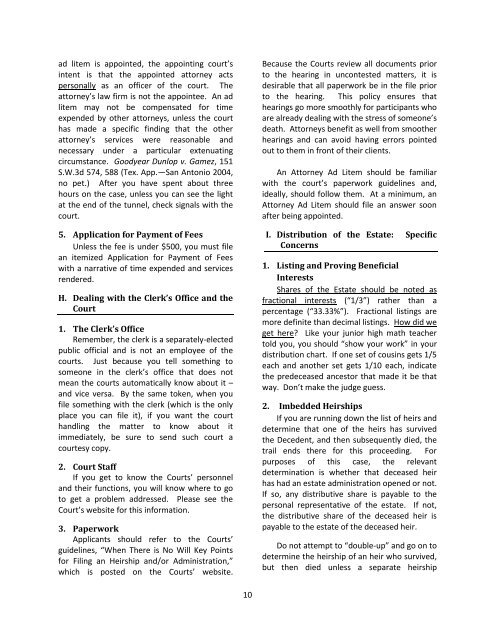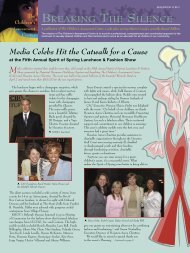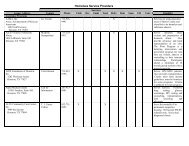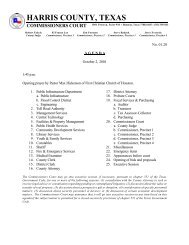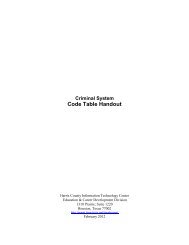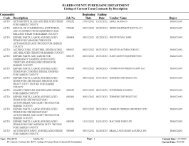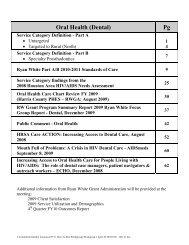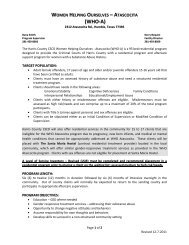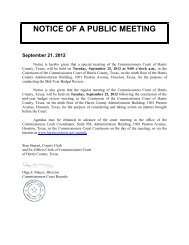Harris County Probate Courts The Ad Litem Manual for Heirship ...
Harris County Probate Courts The Ad Litem Manual for Heirship ...
Harris County Probate Courts The Ad Litem Manual for Heirship ...
Create successful ePaper yourself
Turn your PDF publications into a flip-book with our unique Google optimized e-Paper software.
ad litem is appointed, the appointing court’s<br />
intent is that the appointed attorney acts<br />
personally as an officer of the court. <strong>The</strong><br />
attorney’s law firm is not the appointee. An ad<br />
litem may not be compensated <strong>for</strong> time<br />
expended by other attorneys, unless the court<br />
has made a specific finding that the other<br />
attorney’s services were reasonable and<br />
necessary under a particular extenuating<br />
circumstance. Goodyear Dunlop v. Gamez, 151<br />
S.W.3d 574, 588 (Tex. App.—San Antonio 2004,<br />
no pet.) After you have spent about three<br />
hours on the case, unless you can see the light<br />
at the end of the tunnel, check signals with the<br />
court.<br />
5. Application <strong>for</strong> Payment of Fees<br />
Unless the fee is under $500, you must file<br />
an itemized Application <strong>for</strong> Payment of Fees<br />
with a narrative of time expended and services<br />
rendered.<br />
H. Dealing with the Clerk’s Office and the<br />
Court<br />
1. <strong>The</strong> Clerk’s Office<br />
Remember, the clerk is a separately-elected<br />
public official and is not an employee of the<br />
courts. Just because you tell something to<br />
someone in the clerk’s office that does not<br />
mean the courts automatically know about it –<br />
and vice versa. By the same token, when you<br />
file something with the clerk (which is the only<br />
place you can file it), if you want the court<br />
handling the matter to know about it<br />
immediately, be sure to send such court a<br />
courtesy copy.<br />
2. Court Staff<br />
If you get to know the <strong>Courts</strong>’ personnel<br />
and their functions, you will know where to go<br />
to get a problem addressed. Please see the<br />
Court’s website <strong>for</strong> this in<strong>for</strong>mation.<br />
3. Paperwork<br />
Applicants should refer to the <strong>Courts</strong>’<br />
guidelines, “When <strong>The</strong>re is No Will Key Points<br />
<strong>for</strong> Filing an <strong>Heirship</strong> and/or <strong>Ad</strong>ministration,”<br />
which is posted on the <strong>Courts</strong>’ website.<br />
10<br />
Because the <strong>Courts</strong> review all documents prior<br />
to the hearing in uncontested matters, it is<br />
desirable that all paperwork be in the file prior<br />
to the hearing. This policy ensures that<br />
hearings go more smoothly <strong>for</strong> participants who<br />
are already dealing with the stress of someone’s<br />
death. Attorneys benefit as well from smoother<br />
hearings and can avoid having errors pointed<br />
out to them in front of their clients.<br />
An Attorney <strong>Ad</strong> <strong>Litem</strong> should be familiar<br />
with the court’s paperwork guidelines and,<br />
ideally, should follow them. At a minimum, an<br />
Attorney <strong>Ad</strong> <strong>Litem</strong> should file an answer soon<br />
after being appointed.<br />
I. Distribution of the Estate: Specific<br />
Concerns<br />
1. Listing and Proving Beneficial<br />
Interests<br />
Shares of the Estate should be noted as<br />
fractional interests (“1/3”) rather than a<br />
percentage (“33.33%”). Fractional listings are<br />
more definite than decimal listings. How did we<br />
get here? Like your junior high math teacher<br />
told you, you should “show your work” in your<br />
distribution chart. If one set of cousins gets 1/5<br />
each and another set gets 1/10 each, indicate<br />
the predeceased ancestor that made it be that<br />
way. Don’t make the judge guess.<br />
2. Imbedded <strong>Heirship</strong>s<br />
If you are running down the list of heirs and<br />
determine that one of the heirs has survived<br />
the Decedent, and then subsequently died, the<br />
trail ends there <strong>for</strong> this proceeding. For<br />
purposes of this case, the relevant<br />
determination is whether that deceased heir<br />
has had an estate administration opened or not.<br />
If so, any distributive share is payable to the<br />
personal representative of the estate. If not,<br />
the distributive share of the deceased heir is<br />
payable to the estate of the deceased heir.<br />
Do not attempt to “double-up” and go on to<br />
determine the heirship of an heir who survived,<br />
but then died unless a separate heirship


